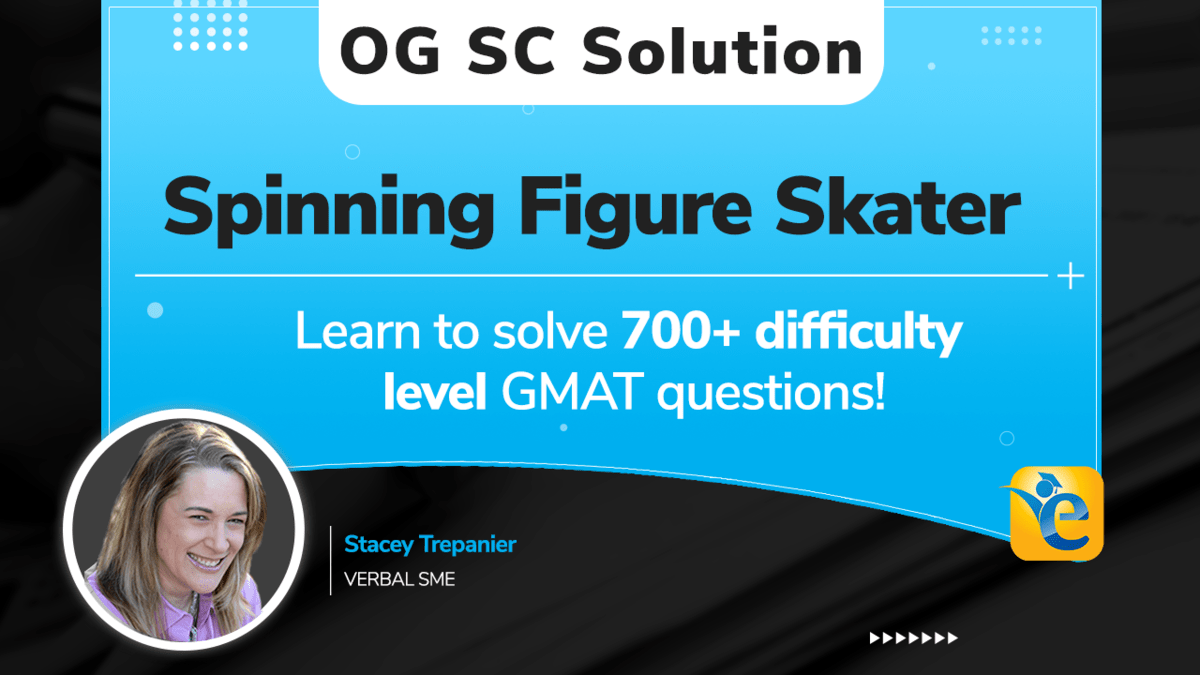In this article, we’ll look at the solution to the 700-level GMAT Official Guide 2022 Sentence Correction question “SC30561.01- During an ice age, the buildup of ice…”.
Here is some general information about this OG question – During an ice age, the buildup of ice at the poles and the drop in water levels near the equator speed up the earth’s rotation, like a spinning figure skater whose speed increases when her arms are drawn in.
- PQID: SC30561.01
- Difficulty Level: Hard
- Most Common Incorrect option choice: Choice A and Choice B
- Question Type: Pronouns
1.1 OG Question – SC30561.01- During an ice age, the buildup of ice…
GMAT OG question – SC30561.01- During an ice age, the buildup of ice at the poles and the drop in water levels near the equator speed up the earth’s rotation, like a spinning figure skater whose speed increases when her arms are drawn in.
[Refer to the Official guide 2022 for options]
This question is all about communicating comparisons correctly! Most of us see the word “like” in the original sentence, go into auto-pilot mode, and bust out our grammar tools. “Like” compares nouns, so what are my nouns, etc. However, we have to be mindful that the comparison in a sentence is communicated correctly. Comparisons are first and foremost about logic and not grammar! So, let’s start with deciphering what is being communicated!
1.2 Communicating the Comparison
Our sentence presents the ice age setting right away for us, and as we keep reading, we learn that the process of the buildup of ice at the poles and the reduction in water levels near the equator speed up the earth’s rotation. Okay, so the author has clearly described a process that takes place during an ice age, and this process of the ice buildup and drop in water levels speeds up the earth’s spin. Cool, easy enough.
Now, we see the word “like” and auto-pilot kicks in, and we may say to ourselves that “like” compares nouns, and what I just read about is a process. Now, this process has two parts — “a buildup of ice” and “a drop in water levels.” These entities are nouns, so it is all good so far. Then we read- “spinning figure skater,” a noun too. Perfect, two nouns have been compared! Hold on. Are we really good? Is the comparison being communicated logically?
I say it all the time, and I know it may seem elementary, but we know we have to compare apples to apples, or in this case, process to process or entity to entity. The process that speeds up the earth’s spin has been compared to a figure skater. This comparison is not logical. The author has not communicated the comparison clearly. If we are patient and keep reading, we will read about how the skater increases her speed when “her arms are drawn in.” There we have it, another process!
Our logical comparison needs to be communicated – the process that speeds up the earth’s rotation compared to the process that increases the speed of a spinning figure skater. Is your head spinning? Let’s lay it on the ice:
As stated, the comparison: A and B speed up X like Y whose…
The logical comparison is A and B speed up the earth’s rotation as a spinning figure skater increases her speed by drawing in her arms.
Once we know the correct comparison that needs to be communicated, it is smooth skating to the right answer.
1.3 Skate right by answers A and B
Now that you understand why option A is incorrect, rejecting option B should not be difficult. However, almost 20% of students reject option A and select option B.
B: like the increased speed of a figure skater when her arms are drawn in
This choice repeats the same error as option A and compares illogical entities. The noun “spinning figure skater” has been replaced with “increased speed,” another noun, but does that fix the communicated comparison? Nope. In addition to repeating the original error, notice that option B completely removes the word “spinning” from the sentence. This word removal leaves this choice on thin ice as we have a change in meaning. The essence of spinning figures is inherently needed in the comparison being communicated.
1.4 Skate by the Cracks in the Ice to Option E
Choice A: like a spinning figure skater whose speed increases when her arms are drawn in
Choice B: like the increased speed of a figure skater when her arms are drawn in
Choice C: like a figure skater who increases speed while spinning with her arms drawn in
Choice D: just as a spinning figure skater who increases speed by drawing in her arms
Choice E: just as a spinning figure skater increases speed by drawing in her arms
Do not dawdle on option D. This choice may look good because of the use of “as,” but notice we have one long noun phrase here: no verb. The comparison is still incorrect.
Glide through to option E. Option E provides a properly communicated comparison. We needed to properly compare the process that speeds up the earth’s rotation during an ice age to the process that increases the speed of a spinning figure skater.
If we use our logic and communicate the meaning clearly and logically, we should not have any cracks in our proverbial ice as we skate through SC comparison questions.
To brush up on the uses of “like,” check out our article on “The usages of “Like” and our article “Like vs. As.”
Happy Learning!
Cheers!
Stacey
If you are planning to take the GMAT, we can help you with a personalized study plan and give you access to quality online content to prepare. Write to us at acethegmat@e-gmat.com. We are the most reviewed GMAT prep company on gmatclub with more than 2400 reviews and are the only prep company that has delivered more than 700+ scores than any other GMAT club partner. Why don’t you take a free trial and judge for yourself?











